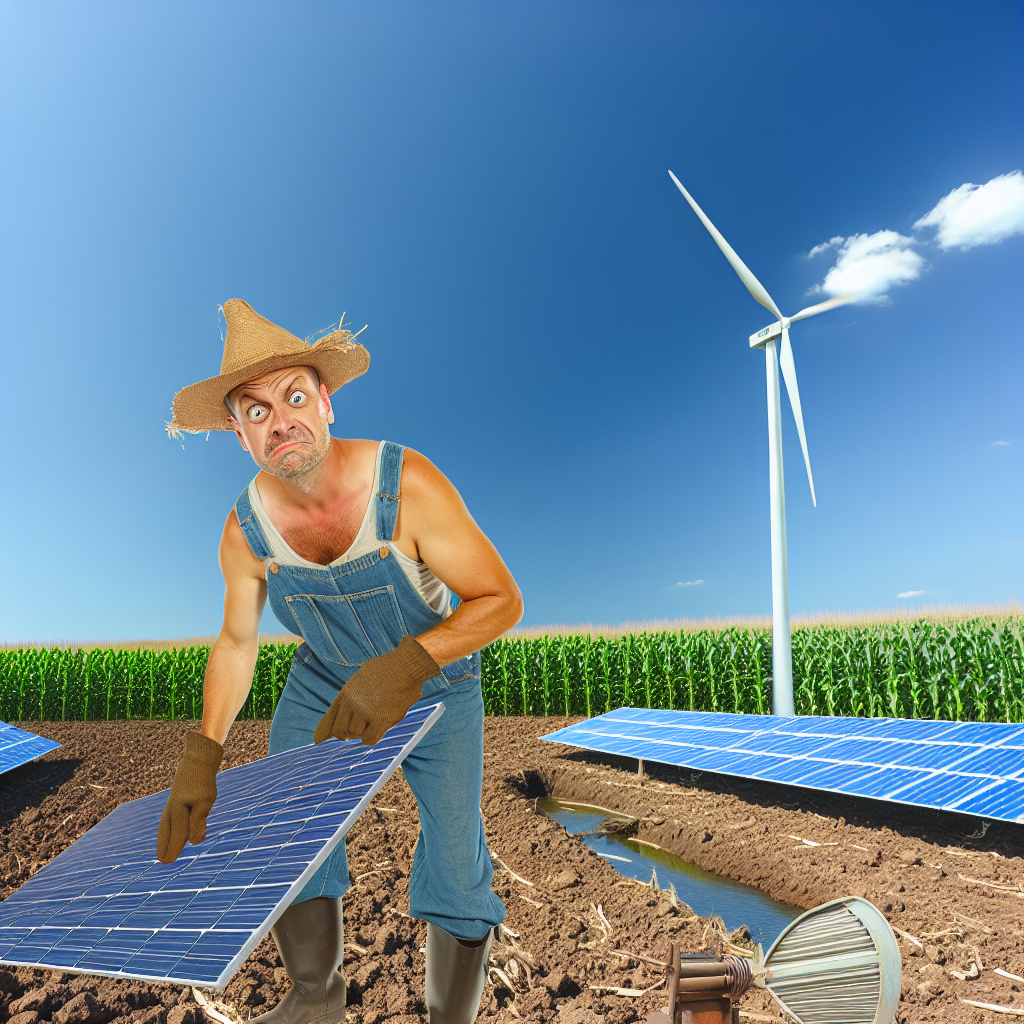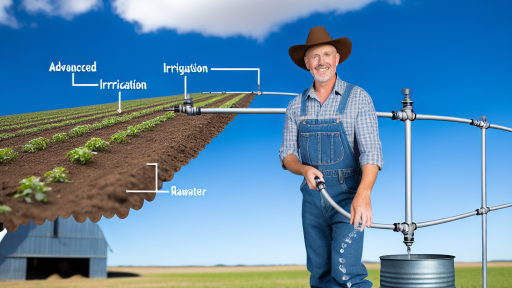Introduction to Renewable Energy in Agriculture
The agricultural sector plays a critical role in combating climate change.
Renewable energy provides sustainable solutions for farming operations.
Farmers increasingly adopt renewable energy technologies for various reasons.
First, these technologies reduce reliance on fossil fuels.
This transition leads to lower greenhouse gas emissions.
Moreover, renewable energy enhances energy security for farms.
Farmers can generate their energy, stabilizing costs and supply.
Additionally, utilizing renewable energy can improve farm resilience.
It allows farms to adapt to changing climate conditions.
For instance, solar panels can power irrigation systems during dry spells.
Implementing wind turbines can help regions with strong wind currents.
Consequently, innovations in renewable energy lead to sustainable farming practices.
Next, we will explore various types of renewable energy sources available.
Types of Renewable Energy Sources
Different renewable energy sources can benefit farms significantly.
Solar energy is one of the most accessible options.
Transform Your Agribusiness
Unlock your farm's potential with expert advice tailored to your needs. Get actionable steps that drive real results.
Get StartedFarmers can install solar panels on rooftops or land.
These panels convert sunlight into electricity or heat.
Wind energy is another viable option for agricultural settings.
Wind turbines can harness wind power to generate electricity.
Moreover, bioenergy utilizes organic materials to produce energy.
Farm waste and crop residues serve as excellent bioenergy sources.
Geothermal energy can also be leveraged for heating needs.
This energy source utilizes heat from the Earth’s interior.
Hydropower can benefit farms with access to flowing water sources.
Benefits of Using Renewable Energy on Farms
Adopting renewable energy offers multiple benefits for farmers.
Cost savings on energy bills is a primary advantage.
By generating their own energy, farmers can significantly cut costs.
Additionally, renewable energy contributes to environmental sustainability.
This approach helps preserve natural resources for future generations.
Moreover, renewable energy improves farm profitability.
Farmers can diversify income by selling excess energy back to the grid.
As a result, energy independence enhances overall farm viability.
This independence shields farmers from fluctuating energy prices.
Ultimately, renewable energy systems can also enhance public image.
Consumers increasingly favor environmentally-friendly products.
Benefits of Renewable Energy for Climate-Resilient Farming
Reducing Carbon Footprint
Renewable energy sources significantly lower greenhouse gas emissions.
Farmers can decrease their reliance on fossil fuels.
As a result, this practice helps combat climate change.
Enhancing Energy Independence
Utilizing renewable energy boosts energy self-sufficiency.
Showcase Your Farming Business
Publish your professional farming services profile on our blog for a one-time fee of $200 and reach a dedicated audience of farmers and agribusiness owners.
Publish Your ProfileFarmers can generate their own power through solar or wind systems.
This independence reduces vulnerability to fluctuating energy prices.
Lowering Operational Costs
Renewable energy can lead to long-term cost savings.
Once installed, solar panels or wind turbines have minimal maintenance costs.
Moreover, they can provide free energy after initial investments are recouped.
Encouraging Sustainable Practices
Adopting renewable energy promotes eco-friendly farming techniques.
Farmers can pair renewable sources with other sustainable practices.
These practices enhance soil health and conserve water usage.
Increasing Resilience Against Climate Change
Renewable energy installations can improve farm resilience.
They enable farms to adapt to extreme weather events.
Farmers can power irrigation systems during droughts effectively.
Attracting Investment and Innovations
Embracing renewable energy can attract green investments.
This investment leads to advancements in agricultural technologies.
Ultimately, innovation supports farmers in overcoming complex challenges.
Solar Energy Solutions for Sustainable Crop Production
Harnessing Solar Power
Farmers can harness solar energy to improve crop production.
Solar panels convert sunlight into electricity, benefiting farming operations.
They provide power for irrigation systems and greenhouse heating.
Furthermore, solar energy reduces reliance on fossil fuels.
Integrating Solar Greenhouses
Solar greenhouses are an innovative approach to sustainable farming.
These structures utilize solar panels, maximizing energy efficiency.
They create a controlled environment, essential for crop growth.
Moreover, solar greenhouses extend the growing season significantly.
Cost Savings and Economic Benefits
Investing in solar technology leads to substantial cost savings.
Farmers can reduce electricity bills, allowing for reinvestment in their operations.
Additionally, solar energy can provide new revenue streams through incentives.
Many regions offer tax credits for solar energy installations.
Case Studies of Successful Implementation
Farmers across the country successfully implement solar solutions.
Agricultural Innovators in Nebraska transformed their practices with solar panels.
This change resulted in a 30% reduction in energy costs.
Sunny Acres Farm in California improved crop yields by incorporating solar greenhouses.
The Future of Solar Energy in Agriculture
The future of agriculture is closely tied to renewable energy solutions.
As technology advances, solar solutions become more accessible for farmers.
Innovations in solar storage technology will enhance energy reliability.
Ultimately, embracing solar energy fosters resilient and sustainable farms.
You Might Also Like: Benefits of Agroforestry in Climate-Smart Agriculture
Wind Energy Utilization in Agricultural Practices
Benefits of Wind Energy for Farms
Wind energy significantly reduces operational costs on farms.
Farmers can lower their electricity bills by harnessing wind power.
This renewable energy source contributes to environmental sustainability.
Additionally, wind energy can create energy independence for farms.
This independence helps farmers mitigate the impacts of fluctuating energy prices.
Showcase Your Farming Business
Publish your professional farming services profile on our blog for a one-time fee of $200 and reach a dedicated audience of farmers and agribusiness owners.
Publish Your ProfileImplementing Wind Energy Solutions
Many farmers are exploring small wind turbines for their operations.
These turbines can generate sufficient power for everyday farm needs.
Furthermore, large-scale wind farms can offer economic benefits to rural areas.
Programs and incentives encourage farmers to invest in wind technology.
For instance, government subsidies can lessen upfront installation costs.
Challenges in Wind Energy Adoption
Despite its benefits, some challenges exist for farmers considering wind energy.
First, initial installation costs can be a barrier for small-scale operations.
Second, not every location is suitable for wind energy generation.
Farmers must assess wind patterns and site conditions thoroughly.
Moreover, regulatory hurdles can complicate the installation process.
Success Stories in Wind Energy
Numerous farms have successfully integrated wind energy into their operations.
For example, Green Valley Farms installed wind turbines to power their facilities.
This installation significantly reduced their operating costs and carbon footprint.
Additionally, Clear Sky Ranch collaborated with local communities to develop a wind farm.
This initiative boosted local job opportunities and promoted green energy.
Future Perspectives on Wind Energy in Agriculture
The future looks promising for wind energy in agriculture.
Technological advancements will likely enhance turbine efficiency.
Moreover, more farmers are recognizing the economic benefits of renewable energy.
Continued advocacy and education can further support wind energy adoption.
Ultimately, wind energy offers a viable pathway for climate-resilient farming practices.
Delve into the Subject: Sustainable Farming Practices to Lower Greenhouse Gases
Bioenergy: Converting Agricultural Waste into Energy
Overview of Bioenergy
Bioenergy utilizes organic materials to generate energy.
Agricultural waste serves as a primary resource for this energy.
This process contributes significantly to sustainable farming practices.
Types of Agricultural Waste
Farmers produce various types of organic waste each season.
This waste includes crop residues, manure, and food processing byproducts.
Moreover, these materials are abundant and often underutilized.
Conversion Technologies
Several technologies convert agricultural waste into energy.
Biogas production is a popular method utilizing anaerobic digestion.
This process generates methane from decomposing organic matter.
Additionally, combustion and gasification are effective for energy generation.
These methods transform solid waste into usable heat and electricity.
Environmental Benefits
Utilizing agricultural waste for energy minimizes landfill use.
This practice reduces methane emissions from waste decomposition.
Consequently, it lowers greenhouse gas emissions overall.
Moreover, bioenergy production enhances soil quality through nutrient recycling.
Economic Advantages
Bioenergy creates new revenue streams for farmers.
It enables the transformation of waste into valuable energy products.
Additionally, local economies benefit from sustainable energy initiatives.
Many farmers report cost savings through reduced energy expenses.
Showcase Your Farming Business
Publish your professional farming services profile on our blog for a one-time fee of $200 and reach a dedicated audience of farmers and agribusiness owners.
Publish Your ProfileCase Study: Green Valley Farms
Green Valley Farms adopted bioenergy technologies in 2021.
The farm transformed livestock manure into biogas energy.
As a result, they reduced their energy costs significantly.
Moreover, they now sell excess energy back to the grid.
Challenges and Solutions
Despite the benefits, challenges exist in bioenergy adoption.
Initial investment costs can be high for many farmers.
To overcome this, government grants and subsidies are available.
Additionally, technical support and training can facilitate transition.
Collaboration with research institutions proves beneficial.
Future Outlook
The future of bioenergy in agriculture looks promising.
Growing concerns about climate change drive innovation and investment.
As technology advances, bioenergy solutions will become more efficient.
Farmers are likely to play a crucial role in this transition.
Learn More: Sustainable Farming with Renewable Energy Solutions

Geothermal Energy for Greenhouses and Soil Management
Introduction to Geothermal Energy
Geothermal energy uses the Earth’s natural heat for efficient farming.
This energy source operates within sustainable limits.
Farmers can harness geothermal energy for various applications.
Benefits of Geothermal Energy in Agriculture
Using geothermal energy reduces reliance on fossil fuels.
This approach lowers greenhouse gas emissions significantly.
Moreover, it enhances energy independence for rural farms.
Geothermal Heating for Greenhouses
Geothermal heating effectively maintains optimal temperatures in greenhouses.
Farmers can use this method to extend growing seasons.
Consequently, they can produce crops year-round.
Greenhouses benefit from lower heating costs as well.
Soil Management Using Geothermal Energy
Geothermal energy supports efficient soil management techniques.
It can help manage soil temperatures during critical growth periods.
Maintaining optimal soil temperatures promotes healthy root development.
This technique can also reduce pest populations naturally.
Implementing Geothermal Systems
Farmers can install geothermal heat pumps for effective heating.
These systems are adaptable to different farm sizes and needs.
Additionally, training and support are available for installation.
Farmers should consider local regulations when implementing these systems.
Real-World Examples of Success
Farmers like Emily Carter have successfully integrated geothermal systems.
Her greenhouse now consumes less energy and produces more crops.
Similarly, Greenfield Farms demonstrated remarkable soil improvement.
The use of geothermal energy led to healthier crops and reduced costs.
Challenges and Considerations
Despite the benefits, geothermal systems come with challenges.
Initial installation costs can be significant for some farmers.
Moreover, the availability of geothermal resources varies by location.
Farmers must assess their specific conditions before investing.
Showcase Your Farming Business
Publish your professional farming services profile on our blog for a one-time fee of $200 and reach a dedicated audience of farmers and agribusiness owners.
Publish Your ProfileFuture of Geothermal Energy in Agriculture
The future looks promising for geothermal energy in farming.
Technological advancements are likely to reduce costs further.
Increased awareness will drive more farmers to adopt this method.
Ultimately, geothermal energy supports sustainable and resilient farming.
Explore Further: Role of Crop Rotation in Carbon Sequestration
Integrating Energy Efficiency Measures in Farming Operations
Assessing Current Energy Use
Farmers should begin by assessing their current energy use.
This assessment helps identify areas for improvement.
Recording energy consumption in different operations is essential.
Understanding peak usage periods allows for better management.
Additionally, monitoring equipment efficiency reveals optimization opportunities.
Implementing Energy-Efficient Technologies
Farmers can invest in energy-efficient technologies to improve operations.
Using LED lighting reduces energy consumption significantly.
High-efficiency irrigation systems conserve water and energy.
Renewable energy sources, like solar or wind, offer long-term benefits.
Adopting energy-efficient machinery minimizes fuel use during operations.
Optimizing Farm Layout
Revising farm layouts can enhance energy efficiency.
Group similar operations to reduce travel time and energy use.
Establishing strategic locations for equipment lowers fuel consumption.
Moreover, planting windbreaks can shield structures from strong winds.
This will create more stable temperatures and reduce heating costs.
Training and Engagement
Engagement with farm workers is crucial for effective energy use.
Training staff on energy-efficient practices fosters a culture of sustainability.
Regular workshops can introduce new technologies and techniques.
Furthermore, involving workers in energy conservation initiatives increases buy-in.
Recognizing their efforts boosts morale and commitment.
Monitoring Performance and Adjusting Practices
Establishing a monitoring system tracks energy usage over time.
This system provides feedback on the effectiveness of energy measures.
Using energy management software can simplify data analysis.
Adjusting practices based on performance metrics is vital for continuous improvement.
Moreover, regular audits can identify new opportunities for efficiency gains.
Case Studies of Successful Renewable Energy Implementations in Agriculture
Solar Energy on Dairy Farms
Sunny Acres Dairy Farm implemented solar power systems effectively.
The installation reduced energy costs significantly for operations.
Moreover, the farm accessed government incentives for sustainability.
This approach enhanced the farm’s overall energy independence.
Wind Turbines for Crop Production
GreenField Farms successfully integrated wind turbines into their landscape.
This initiative provided a reliable energy source for irrigation systems.
Additionally, it reduced reliance on non-renewable energy sources.
Farmers reported lower energy expenses as a result.
Biogas Digestion in Livestock Operations
Happy Hooves Livestock utilized biogas digesters to generate energy.
This technology converts manure into renewable energy effectively.
Showcase Your Farming Business
Publish your professional farming services profile on our blog for a one-time fee of $200 and reach a dedicated audience of farmers and agribusiness owners.
Publish Your ProfileSurplus energy is sold back to the grid for profit.
Furthermore, this process mitigates methane emissions significantly.
Hydroponics and Renewable Energy Integration
Fresh Greens Hydroponics adopted innovative energy solutions.
They combine solar panels with hydroponic systems for efficiency.
This integration optimizes water usage while minimizing energy costs.
As a result, the farm produces year-round fresh produce sustainably.
Community Solar Projects
Neighborhood Farms collaborates on community solar projects effectively.
Farmers share the installation and maintenance costs together.
This arrangement provides them with stable energy prices.
Additionally, it fosters a sense of community and sustainability.
Additional Resources
Climate-Smart Agriculture and Forestry Resources | Farmers.gov
Executive Order on Tackling the Climate Crisis at Home and Abroad …




